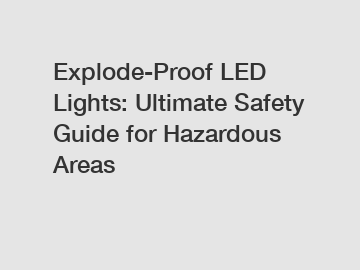Explode-Proof LED Lights: Ultimate Safety Guide for Hazardous Areas
Explode-Proof LED Lights: Ultimate Safety Guide for Hazardous Areas.
In industries where hazardous materials are present, there is always a risk of explosions and accidents. Thus, having proper lighting is crucial to maintaining safety in these areas. Traditional lighting options often fall short in meeting the necessary safety requirements, which is why explode-proof LED lights have emerged as the ultimate solution for illuminating hazardous environments. In this article, we will explore the benefits and features of explode-proof LED lights, and provide a comprehensive safety guide for their use in hazardous areas.
Benefits of Explode-Proof LED Lights.

1. Enhanced Safety: The primary advantage of explode-proof LED lights is their ability to withstand and prevent explosions. These lights are designed with robust materials that can contain any potential sparks or explosions within the fixture, reducing the risk of fire or further accidents.
2. Energy Efficiency: LED lights are known for their energy-saving qualities, contributing to reduced electricity costs. Compared to conventional lighting options, explode-proof LED lights consume less energy and last significantly longer, resulting in reduced maintenance costs and a smaller carbon footprint.
3. Durability: Explode-proof LED lights are built to withstand harsh conditions, making them highly durable and resistant to damage from extreme temperatures, vibrations, and chemicals. They are designed to operate reliably in hazardous environments without compromising on performance.
4. Instant Illumination: Unlike traditional lighting that requires warm-up time, explode-proof LED lights provide instant illumination. This feature is crucial in emergency situations where immediate visibility is essential for evacuating personnel safely.
Safety Guide for Using Explode-Proof LED Lights in Hazardous Areas.
1. Classify the Hazardous Area: Before installing any lighting fixtures, it is essential to identify the classification of the hazardous area according to industry standards. Different areas may have varying levels of risk, and proper classification ensures the selection of suitable explosion-proof lighting for the required zone.
2. Certifications: Ensure that the explode-proof LED lights you choose comply with international explosion-proof certifications such as ATEX, IECEx, or UL. These certifications demonstrate that the lights have undergone rigorous testing and are certified safe for use in hazardous environments.
3. Proper Installation: It is crucial to follow the manufacturer's guidelines for the correct installation of explode-proof LED lights. Improper installation can compromise their safety features and increase the risk of accidents. Additionally, ensure that electrical connections are made by qualified personnel who understand the specific requirements and regulations for hazardous areas.
4. Regular Maintenance: To ensure the ongoing safety and performance of explode-proof LED lights, regular maintenance is necessary. This includes inspecting for any damage, cleaning the fixtures, and replacing any faulty components. Maintenance should be conducted by trained individuals following industry best practices.
Closing Paragraph:
In conclusion, explode-proof LED lights are the ultimate solution for ensuring safety in hazardous areas. Their ability to withstand explosions, energy efficiency, durability, and instant illumination make them an ideal choice for industrial applications. By following the safety guidelines provided in this article, you can maximize the benefits of explode-proof LED lights and protect both workers and facilities from potential risks. For more information or to discuss your specific lighting requirements for hazardous areas, please contact us.
The company is the world’s best Explosion-proof Handle, explosion proof fluorescent fixtures, explosion proof panel board supplier. We are your one-stop shop for all needs. Our staff are highly-specialized and will help you find the product you need.


